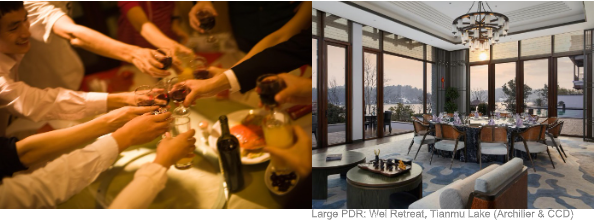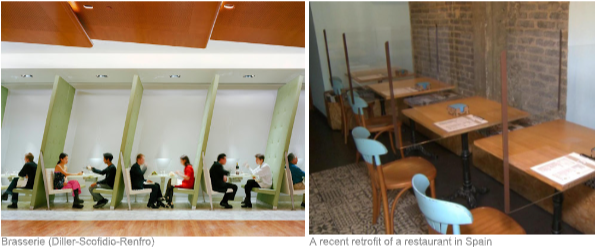As restaurants across the US begin to transition from full closure or pick-up & delivery-only to on-site dining once again, Archilier would like to offer a perspective on public dining and public health that we have gleaned from our experience working in China.
One of the salient features of every upscale Chinese restaurant as well as many average ones is the private dining room, or PDR. It is a universal part of dining culture across China and it may offer a long-term solution for America’s health-conscious diners in contrast to the short-term, good-weather fix of outdoor dining that many restaurants are relying on at present to re-start their operations.
The PDR is strongly tied to China’s business culture, which places a premium on hospitality. Whether holding a working luncheon or entertaining your business associates at the end of the day, booking a private dining room allows the host to appear gracious while also insuring the privacy of one’s conversations. Being in a PDR also promotes the ability to repeatedly toast one’s colleagues (an important part of any Chinese business meal) without the embarrassment of a public display.

PDRs are also popular with family and friends, especially as a way to celebrate a special occasion. There is not really a premium for a PDR except for a reasonable minimum consumption required for upscale outfits or nothing at all for the more regular restaurants. Certainly, we have party rooms and chef’s tables in US restaurants but not at anywhere near the ubiquity that one finds them in China.
In a post-pandemic world, there is an obvious health benefit to dining with a small and trusted group, rather than being thrown into a common dining room with a large group of strangers. And if you’ve ever tried to make yourself heard in a noisy restaurant, the quiet of the PDR is bliss.
Obviously, this is a more capital-intensive model than your typical western restaurant. When Archilier designs a “Chinese” restaurant for one of its hotels or resorts (as opposed to “specialty” restaurants on the western model), often half or more of the total dining area is dedicated to private dining rooms, usually ranging in size from 30sm (320sf) to 60sm (640sf). A more modest restaurant might have smaller PDRs at about 150-200sf for six people, but at 25-30sf/person that is still at the upper range of seating
allowances for many western restaurants where 18-25sf/person might be more the norm.
In addition, Chinese PDRs often have a dedicated pantry for food-warming, tableware, and liquor storage in addition to private toilets and lounge areas, all taking additional floor space.
In urban areas, the PDRs are often on upper floors, with only the kitchen and common dining room at the street level. This introduces another level of logistics around getting hot food to the table, necessitating dumbwaiters or dedicated service elevators, but it seems an operational price that many restaurateurs are willing to pay. Spreading a large restaurant over multiple floors can, however, minimize the amount of expensive premium ground-floor rent the restaurant owner is paying.
Even in cases where the economics of introducing PDRs doesn’t make sense, much can be done to introduce sub-divisions within a common dining room that help patrons feel more sheltered from their fellow diners. A good example is the ceiling-high partitions between the booths at Diller-Scofidio-Renfro’s now-vanished Brasserie, which became a design element in the room. They are certainly preferable, esthetically, to some of the ad hoc solutions we’re now seeing, and certainly no less effective at curbing
airborne exhalations.

Now, for many, the whole point of going out is to revel in the noisy, boisterous throng of humanity, and all this talk of quiet and privacy will sound awfully pathetic. And once we have a vaccine in hand, we hope
that those impulses can once more be safely indulged. In the meantime, however … and perhaps as a hedge against future pandemics (the world has had several, after all, in the last twenty years), the idea of having a large collection of well-designed restaurants that permit some level of social distancing may help guard against future economic disruption on the scale that we’ve just experienced.
Happy – and safe! – dining, everyone!
